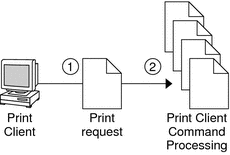|
|||||||||||||||||
|
1. Introduction to Printing in the Solaris Operating System 2. Planning for Printing in the Solaris Operating System (Tasks) Determining a Method to Use for Printer Setup and Administration Planning for Printer Setup and Administration Distributing Printers on the Network Assigning Print Servers and Print Clients Print Server Requirements and Recommendations 3. Setting Up Printing Services (Tasks) 4. Setting Up Printers (Tasks) 5. Administering Printers by Using Solaris Print Manager and LP Print Commands (Tasks) 6. Administering Printers That Use Network Printing Protocols (Tasks) 7. Customizing Printing Services and Printers (Tasks) 8. Administering Character Sets, Filters, Forms, and Fonts (Tasks) 9. Administering Printers by Using the PPD File Management Utility (Tasks) 10. Setting Up and Administering Printers From the Desktop (Tasks) 11. Printing in the Solaris Operating System (Reference) 12. Troubleshooting Printing Problems (Tasks) |
Printer Configuration ResourcesThis section describes the resources that the printing software uses to locate printer names and printer configuration information. The printer software may be configured to use a naming service to advertise the printers. The naming service can be used for storing printer configuration information for all printers on the network. The naming service, LDAP, NIS, or NIS+, simplifies printer configuration maintenance. When you add a printer in the naming service, all print clients on the network can access the printer. Printing Support in the naming service SwitchThe printers database in /etc/nsswitch.conf, the naming service switch file, provides centralized printer configuration information to print clients on the network. By including the printers database and corresponding sources of information in the naming service switch file, print clients automatically have access to printer configuration information without having to add it to their own systems. The default printers entry in the /etc/nsswitch.conf file for files, LDAP, NIS, and NIS+ environments are described in the following table.
For example, if your naming service is NIS, printer configuration information on print clients is searched for in the following sources in this order:
For more information, see the nsswitch.conf(4) man page and System Administration Guide: Naming and Directory Services (DNS, NIS, and LDAP). Adding Printer Information to a naming serviceAdding printer information to a naming service makes access to printers available to all systems on the network. Doing so makes printer administration easier because all the information about printers is centralized.
LDAP Print Support GuidelinesKeep the following in mind when you manage printer information in the LDAP naming service:
How the Solaris Printing Software Locates PrintersThe following figure highlights the part of the print process in which the printing software checks a hierarchy of printer configuration resources to determine where to send the print request. Figure 2-2 How the Print Client Software Locates Printers
|
||||||||||||||||
|